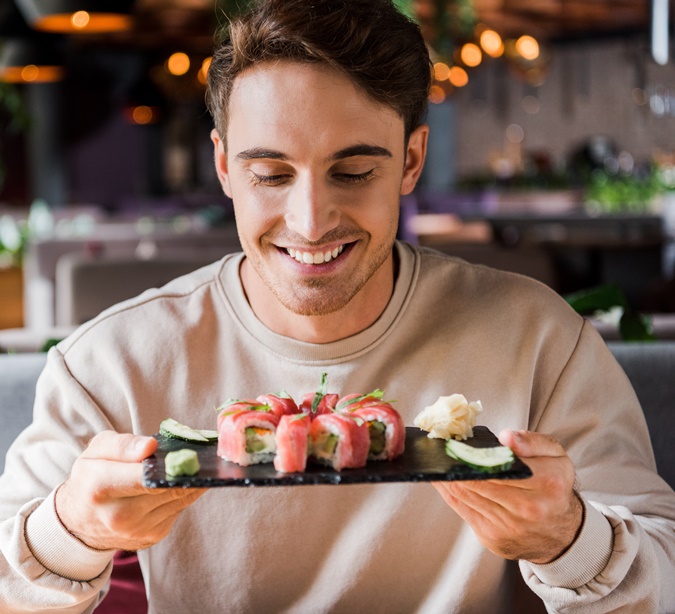 SUSHI ETIQUETTE
SUSHI ETIQUETTE
TRADITIONS ABOUND, BUT THE KEY IS TO RELAX AND ENJOY YOUR MEAL
Sushi dining is often perceived as an elaborate and formal process with a lot of rules ... which it can be. Whether you are eating at a high-end sushi bar or a local family Japanese place, the most important thing to remember is that you are there to enjoy a meal. If you are polite, considerate and enjoy the experience, you will have a great time and no one will be offended. The main thing to remember is just relax, enjoy your meal, and take it as it comes.
You can request to be seated at the sushi bar if you are interested in watching your food being prepared or in making conversation with the itamae (sushi man). If you have a party of three or four people and would like to eat at the sushi bar, it will make conversation much easier if you request corner seats at the bar so that all of your guests are facing each other rather than seated in a row. Even better, make a reservation for this spot in advance. You may also sit at a table in our dining room.
Some diners feel that part of what makes sushi unique is the intimacy that develops between the chef and the customers. Becoming acquainted with the chefs, and returning to the same sushi bar repeatedly, is one of the best ways for a to expand and improve your experience. The chef is likely to serve the most interesting and highest-quality ingredients to regular customers.
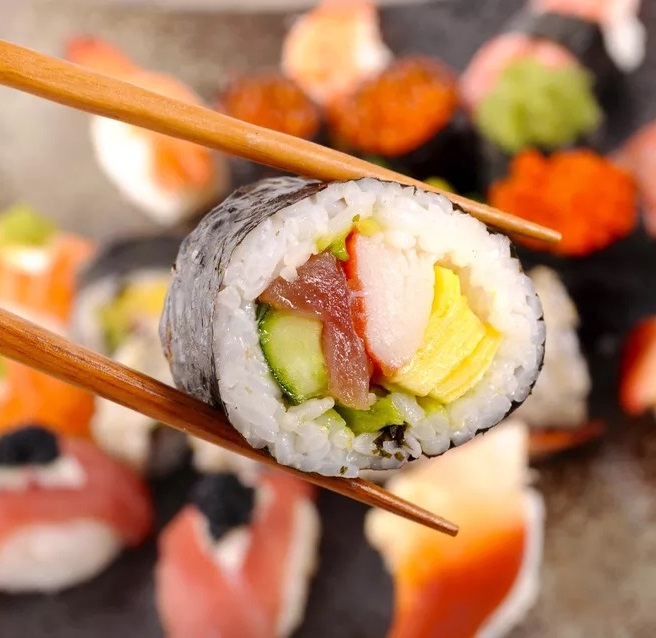 TRADITIONAL RULES; DO'S AND DON'T'S
TRADITIONAL RULES; DO'S AND DON'T'S
There are a lot of traditional rules associated with eating sushi. But remember, you are eating sushi to have a great dining experience, not to partake in an elaborate, stressful historical ritual. To that end, if you enjoy your meal and treat everyone politely and with respect, you will be fine. If you are in a very formal setting, or would enjoy following some of the traditions, a list of some common Japanese etiquette follows
- Don't pick up a piece of food from a common plate or another person’s plate with the end of the chopsticks you put in your mouth.
- When touching other people’s food, do flip your chopsticks around and use the fat ends that you normally hold to touch the food.
- Don't pass food to another person using chopsticks as this is symbolically similar to the passing of a deceased relative’s bones at a traditional Japanese funeral. Do pass a plate instead, allowing the other person to take food offered.
- Eat nigiri style sushi in one bite. As noted above, this is not always easy (or possible) in North America where some itamae prepare huge pieces. Traditional itamae in Japanese will make the pieces that are easy eat in one bite. Do your best and don’t worry if you can’t manage it.
- Slurping noodles is permitted, less so for soup, at least by Japanese standards.
- In more traditional restaurants, if you are not given a spoon for your soup, do not ask for one. You are expected to pick up your bowl to drink the soup, using your chopsticks to direct the solid pieces to your mouth.
- Don't stick your chopsticks in your rice and leave them sticking up. This resembles incense sticks and again brings to mind the symbolism of the Japanese funeral and prayers.
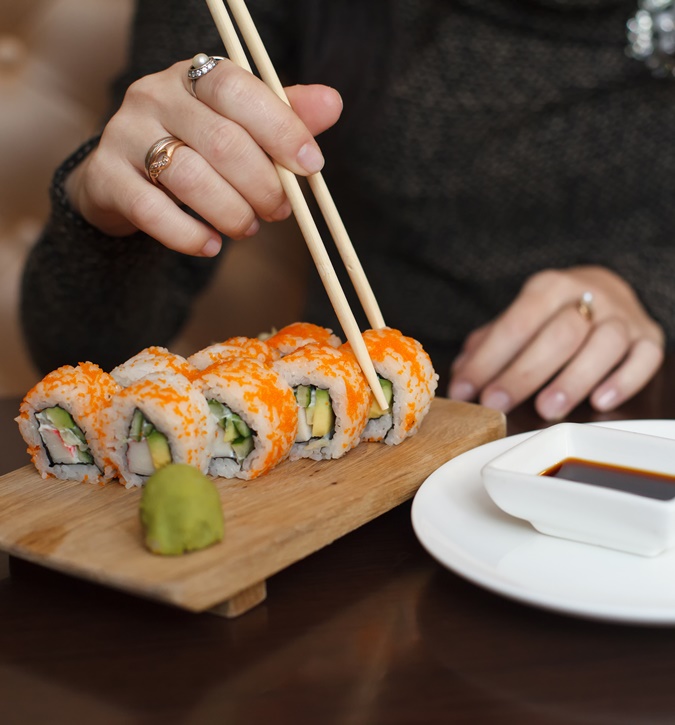 WHAT TO EXPECT
WHAT TO EXPECT
THE SET UP, CHOPSTICKS AND MAYBE A SERVING OF SAKI
There will usually be a set of chopsticks at your place setting. Japanese generally prefer disposable round hardwood chopsticks. While it has become commonplace to rub the chopsticks together to “get the splinters off,” this is considered impolite and should be avoided.
Do you eat sushi with your hands or chopsticks? Technically, both are acceptable. The real trick is how to be respectful with your chopsticks. First, learning to use your chopsticks properly is a big deal. You should never point your chopsticks at other people, nor should you use them as drumsticks or rub them together to remove any signs of splinters. All of these things are considered disrespectful in a sushi restaurant. If a piece is too large for you to handle with your chopsticks, feel free to use your hands instead.When not in use, chopsticks should be placed parallel to yourself on the soy sauce dish or a small plate which may also be given to you. The chopstick tips should not touch the table.
When your order is ready, it is good form to take the plate with both hands and thank the chef. The chef will place orders of nigiri on the geta. If the nigiri comes with more than a dab of sauce, it will likely be served on a separate plate so the geta will remain clean.
In Japan, people usually pair sushi with beer, sake and occasionally soju cocktails, or a combination of the three. Green tea and water are standard non-alcoholic choices. In general, your cup or glass should always be full. If you don’t want to drink any more, just leave a full glass.
Quality sake is increasingly available and can be an integral part of a great sushi meal. Toasting other people in your party, and, occasionally, the sushi chef, is common as well. The traditional toast is “kompai” – which means “empty your cup.” Sake is available both chilled and hot, depending the quality and style. Experiment to learn what you like. In general, higher quality sake is served cold.
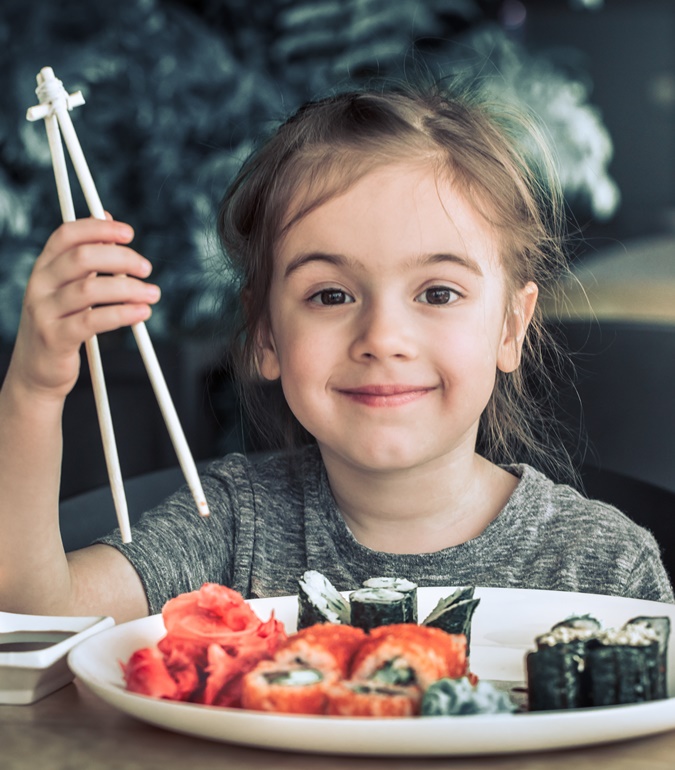 ORDER AND ENJOY
ORDER AND ENJOY
THERE IS A METHOD TO THE MADNESS OF EATING SUSHI
If the sushi bar is busy, there may be a fair amount of time between being seated and the arrival of your sushi. Ordering drinks and appetizers from your server can fill the time and allow for a pleasant transition into the meal. The most common appetizers are edamame – salty, cooked soybeans served in the shell – and miso soup.
The order in which you eat different types of fish is not crucial, but it is generally better to begin with leaner, lighter-tasting fish and progress towards fish with stronger flavors and higher fat content. At most sushi bars, when you order nigiri, the chef will make two pieces per order. It is increasingly common in expensive restaurants to provide only one piece of nigiri per order – it is a good idea check the menu to avoid sticker shock when the bill arrives.
The itamae may have special or unusual items that may or may not be listed on a board near the sushi bar. Feel free to ask for things not listed in the menu. Itamae often have such special items for guests who ask.
Vegetables have always been an important component of sushi, and many traditional varieties are mostly or completely vegetarian. From kappa maki (cucumber roll) to sophisticated nigiri ensembles, itamaes create interesting and delicious vegetarian sushi. If you’re a vegetarian, join your fish-eating friends and just let the itamae know about what you like. Most itamaes will go out of their way to create custom vegetarian sushi to suit your tastes and needs.
When you receive your plate of sushi, first look at what is being served, the number and kind of pieces, and think about the order in which you are going to eat them. Traditional sushi roll -- with the seaweed on the outside -- should be eaten first, before the seaweed gets soggy. If the chef serves a platter, the rolls with seaweed on the outside should be eaten before the nigiri. Sushi should also be eaten as soon as the chef serves it, so that it can be enjoyed at the proper temperature, while the rice is still slightly warm.
Sushi may be eaten with chopsticks or your fingers. Obviously, the formality of the sushi bar and company should dictate the proper etiquette, with chopsticks used in more elegant settings. Traditionally, the entire piece of sushi should be eaten in one bite. It is neater and easier. The tradition of eating sushi in one bite is declining in the U.S. as the portion size has tended to increase (along with the price) as sushi becomes more popular. It's okay to take two bites.
The sushi should be gently dipped in soy sauce, preferably with the fish being the portion covered with the soy sauce rather than the rice. Dipping the fish enhances the flavor of the fish more directly, and prevents the ball of rice from soaking up too much soy sauce and disintegrating.
Soy sauce should not be added if the sushi has been prepared with a sauce or other condiments, such as a barbeque sauce on eel or a combination of flavors on a fresh scallop. Not all types of sushi are appropriate for soy sauce. If the sushi is already dressed, the sushi chef has presumably prepared what they believe to be the optimal balance of flavors. You should feel free to ask the chef if an item should be eaten as served or with soy sauce.
The etiquette for eating sashimi is a bit different. Sashimi, slices of raw fish without rice, should always be eaten with chopsticks. Chefs serve a small mound of wasabi on the side with sashimi. To avoid losing the spiciness and flavor of the wasabi by mixing it with liquid, dab a bit of wasabi directly onto the slice of fish with your chopsticks, then dip a different corner of the fish in soy sauce. The garnishes that come with sashimi, usually a green shiso leaf and shredded daikon radish, are meant to be eaten.
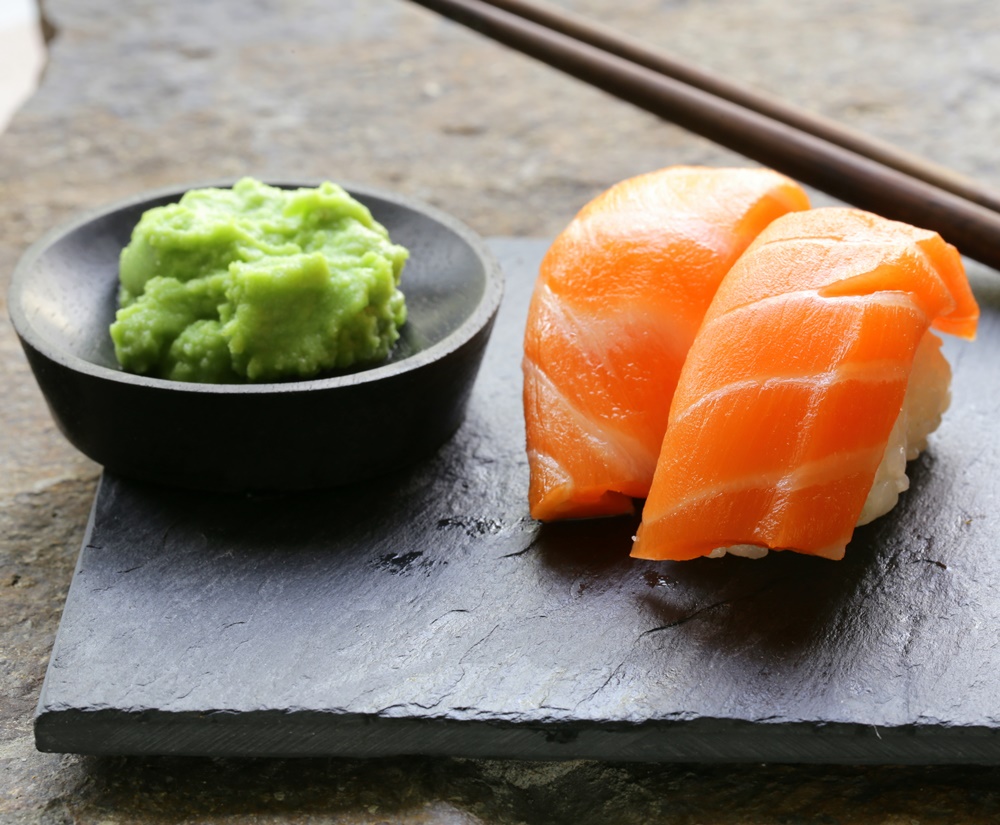 SOY SAUCE, WASABI AND GINGER ENHANCE THE FLAVOR OF SUSHI
SOY SAUCE, WASABI AND GINGER ENHANCE THE FLAVOR OF SUSHI
There will generally be a small carafe filled with soy sauce on the bar, and small round or rectangular dishes near each place setting. You can pour a small amount of soy sauce from the carafe into the dish to use for dipping your sushi just before eating it.
Traditionally, only the fish (and not the rice) is dipped in the soy sauce. The idea is to prevent the rice from absorbing large amounts of soy sauce, which will drown the flavor of the fish and cause the rice on the nigiri to fall apart and otherwise become difficult to eat.
Try eating sushi both ways – with the fish dipped in the soy sauce and with the rice dipped. See which you prefer. If you are using your hands, it is much easier to dip just the fish.
Gari, a pickled ginger served with sushi, is meant to cleanse your palate between various servings, particularly if the fish is strong or oily like katsuo and saba (skipjack tuna and mackerel). Ginger is not meant to be eaten in the same bite as a piece of sushi, and shouldn’t be eaten as an appetizer. If you finish the initial portion served with your plate, it is okay to ask for more.
Wasabi is a strong flavored root that is ground into a light green paste and served with sushi. It has an interesting, complimentary flavor and can help cut and balance the “fishy” flavor associated with stronger, oily fish.
Wasabi is a member of the Brassicaceae family, which includes cabbages, horseradish, and mustard. It is also referred to as “Japanese horseradish.” Wasabi can be freshly grated, which is generally the most flavorful, packaged in a tube, or reconstituted from a dried powder. Wasabi loses flavor rapidly when placed in liquids and should generally be consumed shortly after preparation.
Some chefs, particularly in Japan, put a dab of wasabi between the fish and the rice as they prepare it. Generally, the chef increases the amount of wasabi with toppings that have a high fat content. Many Americans stir extra wasabi into their soy sauce to increase the level of spiciness.
An alternative way to enjoy the wasabi is to pour the soy sauce into the soy sauce dish and place some wasabi in the corner of the dish so that it’s on the edge of the soy dish and not stirred into the soy sauce. Using your chopsticks, swirl the wasabi around in a small area. This is so you can choose to use more or less wasabi as you see fit. Wasabi can be added directly to the top of the sushi before dipping the piece into the soy sauce as well.
Wasabi produces vapors that stimulate the nasal passages more than the tongue. If you get blasted with too much wasabi, try breathing in through your nose and out through your mouth to relieve the burning sensation.
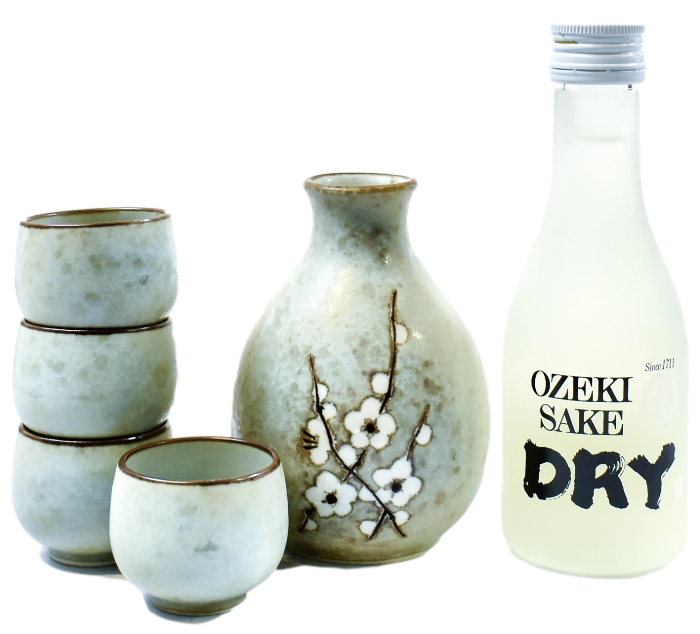 ALL ABOUT SAKE
ALL ABOUT SAKE
SAKE-WA-HONSHIN-WO-ARAWASU*
Sake is often referred to as rice wine, but it’s actually not a wine at all because it’s not made from grapes. In fact, Sake has more in common with beer, which is also brewed from fermented grains. Most sake contains about 16% alcohol. Also like both beer and wine, it can have very unique flavor profiles depending on the ingredients and the brewing process. Unlike beer and wine, most Sake is clear.
Sake is brewed from short grain rice and water under strict oversight of a sake brewmaster. Not a single element can be compromised when brewing premium quality sake. Over the centuries the Japanese have cultivated a special kind of rice perfect for brewing sake. This kind of rice is called saka mai in Japanese, and is very different from the kind of rice people eat. The grain of saka mai is bigger than the regular rice grain. Sake-making rice is improved to contain less protein and fat which might spoil the quality of the sake.
More than 80 percent of sake is made from water. Naturally, the quality of water determines the quality of sake. In fact, the Japanese regions where the quality and taste of water is highly praised are often famous for excellent sake products.
Historically the farmers in the deep mountains and fishermen brewed sake to make a living during the winter season in Japan. These men gradually formed artisanal sake-making groups all over the country. The master or leader of these sake brewers is called a toji. The tradition and knowledge of sake brewing has been passed on from generation to generation by toji for centuries.
Sadly, this ancient Japanese tradition is disappearing fast due to the modern brewing technology that has replaced the old manual method of sake making. However, no matter how advanced the technology has become, nothing can match the knowledge, skills and intuition of the seasoned toji.
*While it’s wine that reveals truth in Latin languages (in vino veritas), it’s sake that ‘reveals the true heart’ in Japan
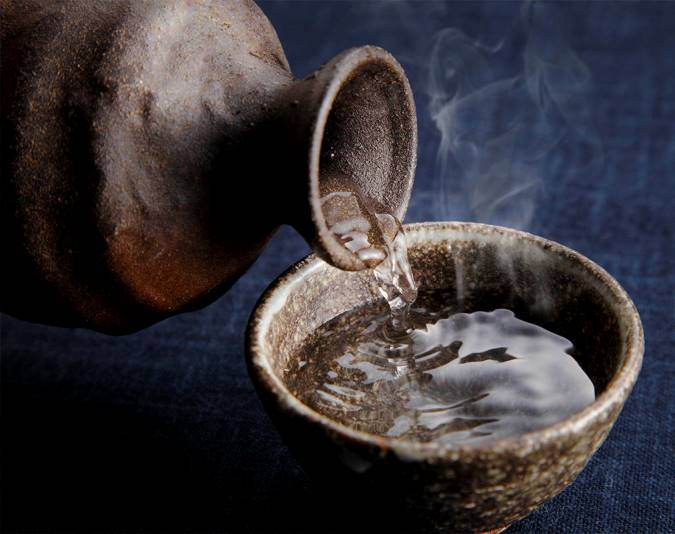 HISTORY OF SAKE
HISTORY OF SAKE
Sake, or rice wine, is about as old as Japanese’s reputation for growing rice, but the origins of sake can be traced to mainland China as far back as 4800 BC. The Japanese are credited with the evolution of the drink since about 400 BC.
Considering the first ochoko of sake brewed pre-dates historical records, most experts estimate the sake recipe is roughly 2,500 years old. The first mention of sake in history books appeared in the third century, where a Chinese history book noted Japan’s taste for sake and its use in mourning the dead.
Fast forward to the 12th century, where history gives more insights into how it was brewed. Shinto shrines and Buddhist temples were common sake-producing grounds creating the techniques that are still in use today.
Brewers used lactic acid fermentation, in which seed mash was used to grow yeast. The lactic acid prevented microbial growth and contamination. During the mashing process, brewers added steamed rice, koji (a mold enzyme), and water in various stages. By the 16th century, sake producing had taken on something of a mass-produced process.
This Japanese staple got a major makeover in the 20th century during World War II, when rice shortages abounded. Brewers had to add pure alcohol and glucose to the seed mash just to maintain supply and demand. Today, the majority produced is still made this way.
Source: Shiso Soy Sauce www.shisosoy.com

